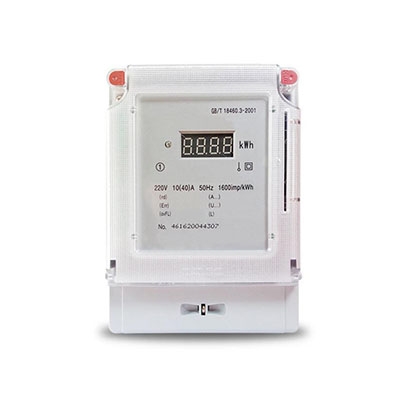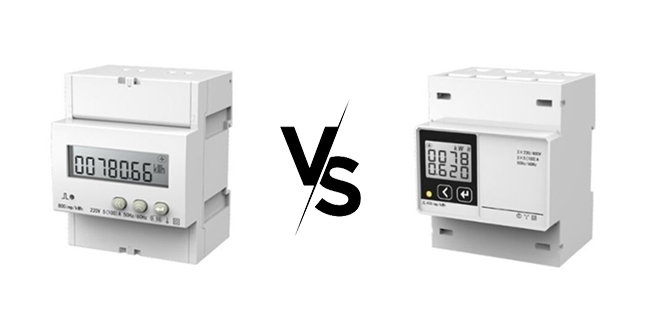An energy meter is used to measure electrical energy, also known as kilowatt-hour meters, fire meters, which refers to the measurement of various electrical meters. In today's era of widespread electricity use, we rely on electrical energy almost every day, yet few people truly understand how that seemingly ordinary energy meter in our homes or industrial facilities works. Whether it’s a traditional mechanical energy meter or a more advanced electronic one, both are built upon intricate principles and technologies. By detecting current and voltage, utilizing magnetic fields, and processing and transmitting data, the energy meter accurately records every unit of electricity consumed. From the rotation of its disk to the collection of digital signals, it serves not only as a tool for power measurement but also plays a vital role in energy conservation, monitoring, and optimization. In the following sections, we will offer you a comprehensive understanding of this seemingly simple yet essential device.
Energy Meter Working Principle
Generally speaking, there are two types of energy meters we commonly use. One is the traditional mechanical energy meter, the other is the digital energy meter. Digital and mechanical energy meters are both measuring devices for electricity consumption, which play a crucial role in the measurement of power consumption in their respective historical stages. The mechanical power function is simply limited to the power data, and the electronic power meter not only enriches the data items of power measurement but also expands many application functions, promoting the development of smart grid. Electronic watt-hour meters have strong functions and strong plasticity, which meet the needs of market development and gradually replace mechanical watt-hour meters. Next, I will explain how the two types of energy meters work.
Mechanical Energy Meter
When an energy meter is connected to the circuit under test, alternating current flows through the current coil and the voltage coil; these alternating currents generate alternating magnetic fluxes in their respective iron cores. The alternating magnetic fluxes pass through the aluminum disk, inducing eddy currents in it. These eddy currents are then subjected to the force of the magnetic field, causing the aluminum disk to rotate (the driving torque). The greater the power consumed by the load, the greater the current flowing through the current coil, and the greater the eddy currents induced in the aluminum disk, resulting in a greater torque that makes the aluminum disk rotate. That is, the magnitude of the torque is directly proportional to the power consumed by the load. The greater the power, the greater the torque, and the faster the aluminum disk rotates. As the aluminum disk rotates, it is also subjected to the braking torque produced by the permanent magnet, which is opposite in direction to the driving torque. The magnitude of the braking torque is directly proportional to the speed of the aluminum disk; the faster the aluminum disk rotates, the greater the braking torque. When the driving torque and the braking torque reach equilibrium, the aluminum disk rotates at a constant speed. The electrical energy consumed by the load is directly proportional to the number of rotations of the aluminum disk. As the aluminum disk rotates, it drives the counter to indicate the consumed electrical energy.

Digital Energy Meter
Compared with the traditional mechanical watt-hour meter, the digital energy meter has many advantages, such as high measuring precision, low power consumption, strong anti-theft ability, and so on. So, how does an electronic watt-hour meter work? Digital power signals are collected into the energy meter through transformers and then undergo analog-to-digital (A/D) conversion through the analog input front-end processor, converting them into digital signals. The sampled data is then subjected to digital filtering and data processing, followed by parameter calculation to output the energy value ultimately. Additionally, it can communicate with other systems.

Basic Parts
Meter Case: The meter case serves as the outer shell, typically made of heat-resistant and insulating materials such as plastic or glass fiber-reinforced plastic. Its primary function is to protect internal components from external environmental factors.
Motor Unit: The motor is the core component of the meter and is responsible for driving the metering disk. It usually comprises stator coils and a rotor. When energized, the motor generates a rotating magnetic field through current interaction, which drives the metering disk's rotation.
Metering Disk: This aluminum alloy disk measures electrical energy consumption. As current flows through the meter, the motor rotates the disk proportionally to the energy consumed. Graduations marked on the disk enable electricity usage readings.
Current Coil: Composed of multiple wire loops, this component measures current flow. The magnetic field generated by the current coil interacts with aluminum elements on the metering disk, creating torque that drives disk rotation. This mechanism directly correlates disk movement to actual power usage.
Main Parameters
- Voltage parameters: Indicate the applicable power supply voltage. For example, if the reference voltage of an electricity meter is 220V, it means that the meter is suitable for a system with a voltage level of 220V, that is, the single-phase voltage of the mains. For three-phase three-wire electricity meters, the voltage is expressed as the number of phases multiplied by the line voltage, such as 3x380V; for three-phase four-wire electricity meters, it is expressed as the number of phases multiplied by the phase voltage or line voltage, such as 3x220/380V.
- Power frequency: Indicates the applicable power supply frequency. The power frequency represents the number of times the direction of the alternating current power supply changes in 1 second. The industrial frequency of the power system in China is 50Hz.
- Rated current and maximum rated current: The current is the base current value for calculating the load. The meter operates at this current condition with the highest accuracy. The maximum rated current refers to the maximum current value at which the electricity meter can work normally for a long time, with the error and temperature rise fully meeting the specified requirements. For example, for a certain electricity meter marked as 1.5(6)A, 1.5 represents the rated current and 6 represents the maximum rated current. Currently, for most electricity meters, the maximum rated current is four times the rated current, such as 1.5(6)A, 2.5(10)A, 5(20)A, 10(40)A, 20(80)A, etc.
- Accuracy class: Common active meters have three accuracy classes: 0.5, 1, and 2. For example, an accuracy of 1 means that the relative value of the deviation between the measured value and the actual value of the meter within the specified range does not exceed 1%.
What Can An Energy Meter Be Used for?
It is an instrument used to measure electrical energy. It accurately records the amount of electricity consumed by household or industrial electrical equipment.
- Monitor Power Usage: Energy meters help users track the energy consumption of various devices. This enables early detection of high energy usage, prompting timely maintenance or replacement to reduce energy waste. They also assist in better allocation of power resources when supply is limited.
- Optimize Power Usage Timing: Users can plan their electricity usage based on meter readings, avoiding peak hours to conserve energy. Meters also help detect power quality issues such as voltage fluctuations or frequency deviations. Any irregular readings may indicate such problems, allowing users to respond promptly.
- Support Energy-Saving Plans: By understanding consumption patterns through meter data, users can develop effective energy-saving strategies. For instance, adjusting the temperature or airflow of air conditioners based on meter readings can help lower energy usage.

Mechanical Energy Meter vs. Digital Energy Meter
- Accuracy Class: Digital energy meters use digital signal processing technology to achieve higher measurement accuracy, reaching Class 0.5 or even 0.2. Mechanical meters, limited by their structure and materials, typically offer Class 1.0 or 2.0 accuracy.
- Stability: Digital meters, using electronic components, are less affected by humidity, vibration, and other environmental factors, ensuring better stability. Mechanical meters, prone to external interference and wear, are comparatively less stable.
- Interference Resistance: Digital meters employ digital processing, offering strong resistance to electromagnetic and capacitive interference. Mechanical ones are more susceptible to such disturbances.
- Lifespan: Digital meters, built with modern components and manufacturing techniques, generally last over 10 years. Mechanical meters, due to wear and aging of parts, typically last around 5 years.
After having a basic knowledge of the difference between mechanical and digital meters, we can know that digital ones are more suitable for modern life and work scenarios. However, electronic energy meters are not limited to just one type. Common ones include single-phase and three-phase energy meters. Then, I will show some details of digital energy meters to help you choose them.
Single-phase Energy Meter vs. Three-phase Energy Meter
Single-phase energy meters are designed for residential and small commercial settings with lower power demands. They operate using a single alternating current (AC) circuit, typically involving two conductors: one phase (live) wire and one neutral wire. This configuration is suitable for powering household appliances and lighting systems. Single-phase meters are known for their cost-effectiveness, straightforward installation, and compact size, making them ideal for environments with limited space. However, they are limited in capacity and may not efficiently handle high-power loads or provide accurate readings in cases of imbalanced loads.
In contrast, three-phase energy meters are tailored for industrial and large commercial applications where higher power consumption is prevalent. These meters operate on three separate AC circuits, utilizing four wires: three phase (live) wires and one neutral wire. This setup allows for a more balanced distribution of electrical loads, enhancing efficiency and stability in power delivery. Three-phase meters can handle heavy electrical loads, making them suitable for operating large machinery and equipment. They offer greater accuracy in energy measurement due to balanced load distribution. However, they are generally more expensive and involve a more complex installation process compared to single-phase meters.
Choosing between single-phase and three-phase energy meters depends on factors such as the total electrical load, type of establishment, future power requirements, and budget considerations. Single-phase meters are appropriate for lower power needs and cost-sensitive applications, while three-phase meters are better suited for environments with substantial power demands and where efficiency and accuracy are critical.

If you're looking to gain a deeper understanding of energy meters, Tool.com is an excellent resource. The platform offers comprehensive guides, technical specifications, and expert insights that can help both beginners and professionals make informed decisions when selecting or using an energy meter. Whether you're interested in mechanical models, digital smart meters, or industrial-grade solutions, it provides reliable information and high-quality products to support your needs.

